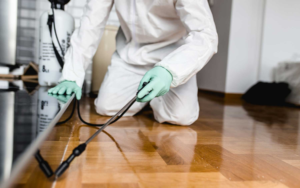Electricians work in customers’ homes (both single- and multifamily), business buildings, and manufacturing plants. They may also work outdoors in a variety of weather conditions. Most states require that electricians complete a training program and gain practical experience.
They install, maintain, and repair electrical power, communications, and lighting systems in homes, businesses, and factories. They also ensure that these systems are up to code. Contact Nash Electric LLC now!

Getting into the field of electricians requires a combination of education and training. The educational requirements vary from state to state, but most include a certificate program, an apprenticeship, and licensure. Students typically take classes in electrical systems and wiring, as well as safety. They also participate in an internship to gain experience.
Licensing for electricians varies by county, but most require a minimum of 144 hours of classroom work and 2,000 hours of hands-on job training under the supervision of a master electrician. Some programs offer academic credits, which can shorten the length of the apprenticeship. However, these credits are limited and do not replace the required work experience.
The skills that an apprentice learns while completing their apprenticeship are valuable and can be applied to many different careers. These skills include reading blueprints, electrical diagrams, and specifications to understand the layout of a project and to determine what tools and materials are needed. They must also be able to troubleshoot problems and repair electrical devices. Other important skills include critical-thinking and problem-solving, which allow them to assess issues and develop effective solutions.
Electricians often work on construction sites, where they collaborate with other tradespeople to install electrical systems in new buildings. They also maintain the electrical systems in commercial and industrial facilities. In these roles, they may need to choose the proper wire or cable for a particular job, as well as use tools like ohmmeters and voltmeters to test them. They must also follow strict standards to ensure the safety of their work and adhere to electrical codes and regulations.
There are a number of specialties within the field of electricians, including line workers, electronic craftsmen, and meter and relay technicians. Each of these roles focuses on the assembly, installation, or maintenance of a different type of electrical system in the marine energy industry.
The career of an electrician can be rewarding and challenging. It requires a lot of physical stamina and the ability to think critically when troubleshooting issues. Additionally, it is important to have excellent customer service skills because electricians work with customers on a daily basis.
Training
If you want to become a licensed electrician, you must complete classroom training and on-the-job experience. Many trade schools offer both programs. However, some people choose to skip formal programs and enter the field as apprentices or entry-level technicians. An apprenticeship program typically requires a certain number of work hours and supervised on-the-job training under the supervision of a certified journeyman electrician. These programs are often sponsored by unions, such as JATCs, but they can also be non-union and private.
During the course of training, electricians must learn about the different aspects of electrical theory, blueprint reading, mathematics, and electrical code requirements. Students may also receive specialized instruction in areas such as soldering, communication systems, and fire alarm systems. In addition to this, they must be able to work under high voltage, in confined spaces, and use ladders and scaffolds.
Safety is an important part of every electrical training program. Without proper safety protocol, accidents can occur such as electric shocks or fires. This is why all electricians are required to undergo safety training in their early career. The training discusses proper safety procedures, such as how to select the correct wire or cable for a job and how to pull it through conduit runs. It also covers the importance of grounding, which is the return path for electric current.
A career as an electrician is a great choice for someone who wants to work on their own schedule and set their own wages. In addition, the pay is much higher than in most other occupations. Some electricians even make enough to start their own businesses and compete with larger companies for jobs.
The best way to prepare for a career as an electrician is to attend a vocational school that offers an apprenticeship training program. These programs typically take 2-4 years to finish and can be completed at an area community college or technical school. The course of study will include classroom and lab-based instruction as well as hands-on field experience.
Once you have a good understanding of electrical principles and are ready for the journeyman exam, it’s time to apply for a job. Depending on your skills and the market conditions, you might be able to find a position with one of the nation’s leading contractors.
Job outlook
In a world where job security is hard to find, electricians enjoy a strong career outlook. This is due to consistent demand for electrical services and the fact that they are essential for keeping homes and businesses running. They also tend to be less vulnerable to economic downturns and technological obsolescence than other trades. Additionally, electricians typically earn a higher wage than other workers in similar fields.
Electricians typically need a high school diploma or equivalent and then complete an apprenticeship program, a blend of on-the-job training and classroom learning. This program often lasts 4-5 years and covers subjects like blueprint interpretation, electricity theory, mathematics, code compliance, safety protocols, and more. The program is sponsored by unions or contractor associations and often includes a mix of hands-on learning and supervised classroom work.
Once apprentices have completed their training, they will be qualified to perform a wide range of electrical tasks, from residential wiring to industrial electrical systems. The demand for electricians will continue to rise as older buildings are renovated and alternative energy sources like wind and solar become more commonplace. In addition, the need to connect these new power systems to existing electrical grids will also increase demand for electricians.
Those who specialize in particular areas, such as industrial electrical systems and renewable energy installation, will likely earn more than other electricians. This is because these professionals are in high demand and have a unique set of skills that sets them apart from other electricians. Continuing education and staying abreast of the latest developments in their fields is another way that electricians can boost their earning potential.
In a world where many people are searching for “jobs that don’t require a degree”, a career as an electrician could be the right choice. With a solid job outlook and excellent pay, this is one career that is worth considering.
Salary
The salary of an electrician depends on a number of factors, including specialization and location. Those who specialize in residential and commercial work typically earn less than those who work on industrial sites, but they can still make good money. In addition to their base salary, many electricians are eligible for overtime and other bonuses. These can be a great way to increase their income and can motivate them to perform at the highest level.
Electricians are skilled tradespeople who design, install, maintain, and repair electrical wiring and equipment in a variety of settings. They also ensure that electrical work is completed safely and in compliance with regulatory standards. They read and interpret blueprints, electrical diagrams, and specifications to understand the layout of a project and determine the materials and tools needed. They may also work on high-voltage systems or other specialized projects.
In addition to hourly pay, electricians also receive benefits like health insurance and a retirement plan. They may also be entitled to other perks, such as paid time off and gym memberships. They can also advance their career by taking additional training and earning certifications. Some employers may even offer profit-sharing or incentive bonuses to their employees.
Those who wish to maximize their earnings should consider starting their own business. This option requires a significant amount of capital, but it can provide a substantial financial upside. Moreover, it can allow them to bypass the middle man, who usually takes a substantial cut of their salary.
Other ways to boost your salary as an electrician include taking on more complex projects and acquiring more skills. These improvements can lead to higher job satisfaction and a greater reputation, which often results in increased earnings. If your employer doesn’t offer overtime or other perks, you can always file a class action lawsuit against them for unpaid overtime.
The most lucrative careers for electricians are those in the specialized fields of commercial and industrial settings. These workers handle large-scale projects and must be knowledgeable about public safety requirements. In addition, they are responsible for installing and maintaining high-voltage systems in industrial facilities. These responsibilities can be very demanding, and they are often subject to frequent inspections.








